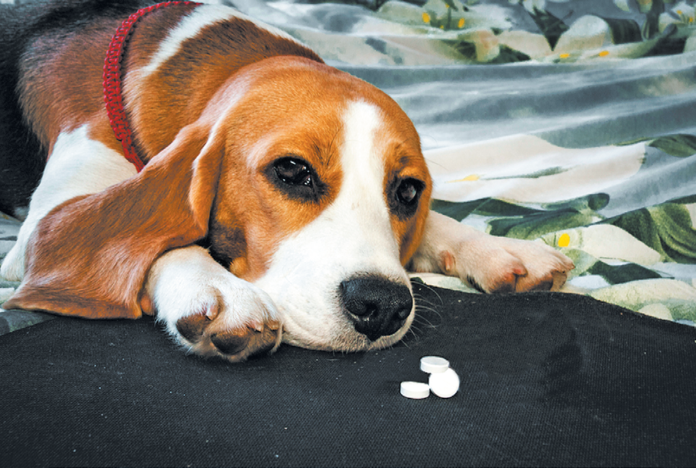About one quarter of all phone calls to the Animal Poison Control Center are about human medications, says the American Veterinary Medical Association (AVMA). “Your pet can easily ingest dropped pills or may be given harmful human medications by an unknowing owner, resulting in illness, or even death, for your pet.” At the same time, certain over-the-counter medications you have on hand can be used on your pet for the very same ailments they mitigate in you. Here’s a guide to what’s safe and unsafe for canine bodies.
SAFE
(Note: You should always consult with your vet about whether a particular drug is a safe bet for your dog and also to go over dosages. The right amount for a 150-pound person may not be right for a 35-pound dog.)
Antifungal products. For a dog with a fungal infection, an anti fungal spray, gel, or cream that contains miconazole will keep her comfortable until she comes in for a veterinary visit. In uncomplicated cases, it may even clear up the problem.
Artificial tears. Products like Genteal and Soothe XP calm minor eye irritations and also help clear up mild conjunctivitis. (They will not help if your dog has colored discharge — including white discharge — extreme redness or swelling, or pain (your dog will blink more than usual or keep her eye closed.)
Benadryl (diphenhydramine). As in people, this drug can relieve itchiness — but proper dosing is critical. The standard dose for Benadryl taken orally is 1 milligram per pound of body weight, three times a day. The standard tablet in many pharmacies is 25 milligrams, making it appropriate for a 25-pound dog.
Hydrocortisone cream. Applied topically, it can reduce itching caused by insect bites and allergies. It’s “good for a once or twice application,” says Tufts emergency and critical care veterinarian Armelle de Laforcade, DVM. If the itching continues, you need to bring the dog in.
Hydrogen peroxide (10 percent strength). It can induce vomiting, and your vet or poison control center can tell you the correct dose. Just know that induction of vomiting is not always appropriate. Sometimes it can worsen a poisoning depending on the toxin. Make sure the person on the other end of the line knows why you want to induce vomiting before you go ahead.
Pepcid AC (famotidine). This can really help with a bout of diarrhea or other tummy upset. But the safe dosage definitely depends on your dog’s weight, along with other drugs she may be taking. Learn the right amount from your vet.
Styptic pencil or powder. If you shave too closely and nick yourself, it can help stop the bleeding. Ditto for a dog whose nail you have cut too close to the quick.
Triple antibiotic ointment. A dog with a wound can have this applied topically upon direction by a vet. It will help inhibit bacterial growth and, therefore, an infection.
Zyrtec (cetirizine). An antihistamine, it can be used to treat dermatitis, which makes a dog’s skin itchy. It’s often the next step when Benadryl doesn’t do the trick.
UNSAFE
Adderall. This drug, used to treat Attention Deficit Hyperactivity Disorder (ADHD) in children, is a combination of four different amphetamines. In dogs, it acts as a stimulant, raising heart rate and body temperature and causing hyperactivity, tremors, and even seizures. Make sure this medicine never goes near your pet’s mouth.
Aleve (naproxen). Even in small amounts, this pain reliever can cause stomach ulcers and kidney failure in dogs.
Cymbalta (duloxetine). It’s an antidepressant for people but can bring on agitation, tremors, and seizures in our pets.
Ibuprofen. Often sold under the brand names Advil or Motrin, this is the most common human medication ingested by pets, according to the AVMA. That’s because many brands have a sweet outer coating that makes it appealing to dogs. The problem is that it can cause stomach ulcers and even kidney failure in our canine friends. “‘Think M&M’ but a potential deadly one,” warns the AVMA.
Tylenol (acetaminophen). It’s worse for cats but no friend to dogs, either. It can cause liver damage and also damage your dog’s red blood cells. Those are the cells that carry oxygen to all the body’s tissues.
Xanax (alprazolam). This sleep aid and anti-anxiety medication is often left out on the nightstand so people remember to take it. That makes it commonly ingested by dogs, says the AVMA. Most of the time, it will simply make pets sleepy and wobbly, but sometimes a paradoxical reaction occurs — a dog will become agitated. More important, large doses of alprazolam can cause blood pressure to drop and lead to weakness or collapse.





